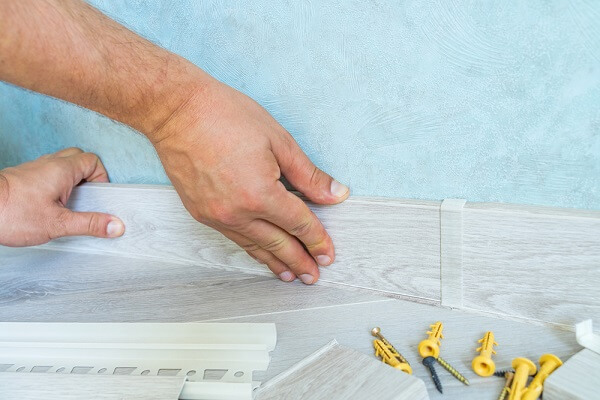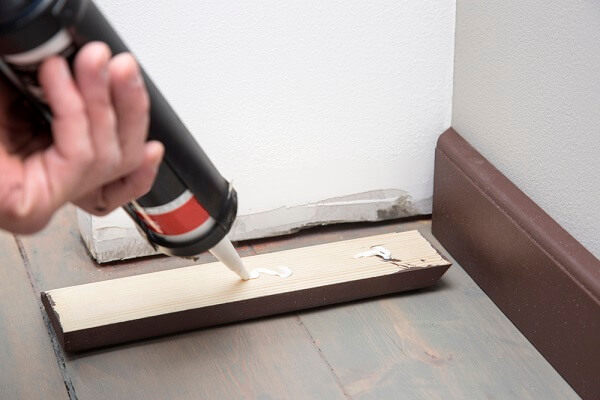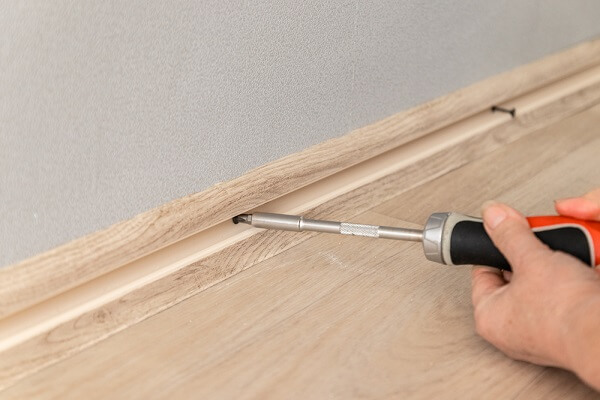Mastering Baseboard Installation: A Comprehensive Guide Beyond Nail Guns

Imagine this: you’re engrossed in your recent domestic enhancement venture. You’ve acquired the hues, the ornamental coverings, and the hardware. But hold on, there’s a hitch! You’ve got to affix the skirting boards, but a nail gun is missing? Worry not, comrade, as we are equipped with suitable alternatives!
When undertaking a room redecoration or renovation project, it is essential to install baseboards as a finishing touch. Baseboards serve the dual purpose of safeguarding the lower perimeter of your walls and imparting a refined, finished appearance to your area. Although this task may seem daunting, particularly if you are a novice in the DIY realm, it is certainly achievable with some perseverance and expertise.
In the realm of DIY and professional carpentry, you may find that nail guns have become the preferred tool for baseboard installations due to their rapidity and effectiveness. You can benefit from the time and effort saved by utilizing quick nailing techniques, particularly for larger projects. However, it is understood that not everyone possesses a nail gun or favors its usage.
If you were informed that it is possible to install baseboards with accuracy and convenience without the use of a nail gun, you may be interested to know that this is indeed the case. You are correct. You may find that utilizing conventional techniques such as employing a hammer and nails, or even contemporary options like robust adhesives, can prove to be efficacious. This blog post aims to provide you with the necessary knowledge and confidence to complete your baseboard installation project, whether or not you choose to use a nail gun.
Detailed Breakdown of Baseboard Installation
To achieve a smooth and efficient installation of baseboards, you will need to utilize a specific set of tools. Typically, you would require a set of tools comprising a measuring tape, miter saw, coping saw, level, nail gun, and putty knife. If you do not possess a nail gun, there is no need to lose hope. You can also utilize a traditional hammer and nails to accomplish the task. Alternatively, you may consider utilizing a robust adhesive that is appropriate for both wood and drywall as a viable solution.
Material Selection: Choosing the Right Baseboards
When selecting baseboards, it is crucial to consider their dual function of providing both aesthetic appeal and protection. You may find baseboards available in a range of materials, such as solid wood, medium-density fiberboard (MDF), PVC, and even tile or stone. When selecting a baseboard, it is important to consider several factors that will impact your decision. These factors include the intended purpose of the room, the desired aesthetic, your budget, and the environmental conditions that the baseboard will be exposed to, such as dampness.
Basic Steps of Installing Baseboards with a Brief Note on Using Nail Guns
When installing baseboards, you will need to measure the length of the wall, cut the baseboards to fit, and then attach them to the wall. When using a nail gun, it is recommended to utilize 2-inch brad nails and drive them through the baseboard into the wall studs. For corners or joints, it is recommended that you make precision cuts using a miter saw to ensure a snug fit.
Read More: Can You Use a Nail Gun on PVC Trim?
Statistics: Percentage of DIY-ers Using Nail Guns vs Traditional Methods
It can be challenging to obtain exact figures on this matter. However, based on several surveys and reports, it appears that approximately 65% of DIY enthusiasts utilize a nail gun for the purpose of installing baseboards. However, you may find it noteworthy that a considerable 35% of individuals still depend on conventional techniques such as utilizing hammers and nails or even adhesive methods. Based on the data presented, it can be concluded that there are alternative methods available for baseboard installation aside from the commonly used nail guns.
How to Nail Baseboards Without a Nail Gun

Before the invention of the nail gun, you would install baseboards using the traditional method of manual nailing. When securing the baseboard to the wall, you may opt for manual nailing which entails using a hammer and nails. Although it may require additional time, this method is both cost-effective and uncomplicated, making it accessible to all individuals.
Advantages and Disadvantages of not Using a Nail Gun
You can benefit from manual nailing. You may find that utilizing a hammer provides a greater degree of accuracy and manipulation than a nail gun in certain situations. It is cost-effective for you as there is no requirement to purchase an expensive nail gun or air compressor. However, it is important to note that larger projects may require a significant amount of time and physical effort.
Step-by-step guide:
- Preparation and Safety: Before you start, make sure you have all the required equipment. It is recommended that you wear safety goggles and gloves. Ensure that your work area is adequately illuminated and devoid of any hindrances.
- Measuring and cutting the baseboard: To ensure accurate fitting, it is recommended that you measure the length of the wall and proceed to cut the baseboard using a miter saw. Please ensure that you cut the end pieces at a 45-degree angle when creating corner joints.
- Nailing the baseboard: For manual nailing, it is recommended that you utilize a high-quality claw hammer and finishing nails. You should ensure that the nails are of sufficient length to penetrate the baseboard and firmly affix it to the wall. Typically, you would use 2-inch nails for the task at hand. To properly secure the baseboard, it is recommended that you drive a nail through the thickest part of the board and into the wall studs.
- Finishing touches: To fill in the nail holes, you should use wood putty and a putty knife. Once it has dried, you should proceed to sand it smooth and perform any necessary touch-ups with paint.
Case Study: A Personal Anecdote About Manual Nailing Success
You may remember a time when you assisted a friend in the renovation of their living room. You do not possess a nail gun, and acquiring one is not within your financial means. You utilized a hammer and nails to properly install the baseboards. Although the task required more effort, the feeling of achievement upon completion was significant for you. You can observe that the baseboards are firmly affixed and exhibit a polished appearance, indicating that conventional techniques can often produce equally satisfactory outcomes.
Alternatives to a Nail Gun
Detailed List of Tools One Can Use if They Don’t Have a Nail Gun
1. Hammer and Nails

You may consider utilizing a claw hammer and finishing nails as a conventional and uncomplicated choice. You are provided with a sense of control and they are readily accessible.
2. Adhesives/Glue

You can consider utilizing a robust construction adhesive as a substitute. The adhesive you select should be appropriate for bonding wood to drywall.
3. Screwdrivers

When securing baseboards, screws can also be utilized, although they are not as frequently used. You will require either a manual or an electric screwdriver for this task.
Pros and Cons of Each Alternative
1. Hammer and Nails
Pros: You are able to maintain control over the situation while also ensuring accessibility and affordability.
Cons: Performing this task can be time-consuming and physically taxing for you. Additionally, there is a potential risk of hammer marks on the baseboards.
2. Adhesives/Glue
Pros: The product is designed to be user-friendly, ensuring that you can operate it with ease. It is engineered to leave no visible holes, and its noise level is minimal, providing you with a peaceful environment.
Cons: You may experience extended drying time, comparatively lower strength than nails, potential for mess, and unsuitability for heavy baseboards.
3. Screwdrivers
Pros: You can expect a robust grip with the ability to remove screws as necessary.
Cons: When installing baseboards, it is important to note that using nails or screws can create visible holes and be time-consuming. Additionally, this method is not considered traditional for baseboard installation.
Safety Guidelines for Each Alternative
- Hammer and nails: You should wear safety goggles to safeguard yourself from any potential harm caused by flying debris. Additionally, it is recommended that you utilize a nail set to prevent any accidental hammering of your fingers.
- Adhesives/Glue: It is recommended that you utilize a well-ventilated area when using the adhesive. It is also advised that you wear gloves to prevent skin contact. Additionally, it is important to be mindful of the adhesive’s drying time.
- Screwdrivers: To prevent wood splitting, it is recommended that you pre-drill holes before fastening. Additionally, it is important to exercise caution and avoid overtightening, as this may cause damage to the baseboard.
If you’re looking to expand your knowledge beyond nailing, check out our latest article on ‘how to nail baseboards without a nail gun‘, where we delve into reader-recommended approaches for achieving seamless results.
Comparative Analysis: Nail Gun vs Alternatives in Terms of Efficiency and Results
Using a nail gun is the most efficient method in terms of time and ease for you. For professional use and larger projects, it is ideal. However, you can find comparable results with the available alternatives. If you are seeking control and a stronghold, utilizing a hammer and nails would be an ideal option. When utilizing adhesives, it is possible to achieve a neat appearance without any apparent punctures, but it may not be as durable as other options. You may find that screwdrivers offer a removable option that is well-suited for temporary installations. However, it is important to note that achieving a clean finish with this tool may require additional effort.
Frequently Asked Questions (FAQs)
Q: 16 or 18-gauge nailer for baseboard?
Ans: When selecting a nail, it is important to consider its diameter, which is commonly referred to as the “gauge.” In the realm of nails, it is important to note that a larger gauge number signifies a smaller diameter nail. Therefore, you can conclude that an 18-gauge nail is thinner than a 16-gauge nail. The thickness of your nail can significantly affect its holding capacity and the visibility of the resulting nail hole.
Expert recommendation and justification
When installing baseboards, it is recommended to use a 16-gauge nailer. You will find that the holding power provided is sufficient to effectively secure the baseboard, while also leaving a hole that can be easily filled for a smooth finish. You may consider utilizing an 18-gauge nailer for thinner or more delicate baseboards, as it has the potential to cause less damage to the wood.
Q: Is it better to glue or nail baseboards?
Ans: When installing baseboards, it is recommended to utilize the traditional method of nailing for a durable and secure hold. You can fill the nail holes and paint over them to achieve a smooth finish. When opting to glue baseboards, it is important to note that this method may not be as effective for heavier baseboards, despite its less invasive nature and absence of visible holes.
Expert opinion based on different scenarios
When deciding whether to glue or nail baseboards, it is important to consider the specific circumstances at hand. For your standard installations, it is recommended to use nailing as it is a reliable method that offers high strength and durability. For lighter or temporary installations, or when seeking to avoid wall damage, adhesive can serve as a suitable alternative.
Q: What nails do you use to install baseboards?
Ans: You can utilize various types of nails for the installation of baseboards, such as finishing nails, brad nails, and small casing nails. When selecting a nail for attaching your baseboard to the wall, it is important to consider the thickness of the baseboard and the type of wall it will be affixed to.
Expert advice on choosing the right nail for your baseboard
When installing baseboards, it is common to opt for finishing nails. You will find that the small, barrel-shaped head of this tool allows for easy driving below the surface of the wood, resulting in a smooth finish. A length of 2 inches is frequently appropriate for your needs. When using a nail gun, it is common to opt for 16-gauge brad nails. You should always ensure that the nails are of sufficient length to secure the baseboard to the wall stud, in order to achieve a sturdy hold.
Wrapping Up
In this comprehensive guide, you will be taken on a detailed exploration of the process involved in installing baseboards without the use of a nail gun. You have been provided with an overview of the fundamental steps involved in baseboard installation, a comparison of the advantages and disadvantages of utilizing a nail gun versus manual nailing or adhesive application, and common inquiries related to this subject have been addressed. You have been provided with a range of tools and techniques to guarantee the secure and tidy installation of your baseboards.
The flexibility offered by DIY projects such as this is quite remarkable. While you are seeking speed and efficiency, it is important to note that nail guns are not the sole alternative. One can attain professional outcomes by utilizing conventional techniques such as hammering and nailing or contemporary alternatives like adhesives. To optimize your project, it is recommended that you select the method that aligns with your comfort level, the tools available to you, and the unique requirements of your project.
As someone who has extensively evaluated various tools and undertaken numerous home improvement projects, rest assured that there is no greater sense of fulfillment than accomplishing a task with your own hands, utilizing the tools and techniques that are most suitable for you. Remember, when engaging in DIY projects, it is not solely about completing the task at hand. It is also about acquiring knowledge, developing skills, and enhancing your self-assurance in your capabilities. You may proceed with the installation of the baseboard. Whether you utilize a nail gun, a hammer, nails, or adhesive, you possess the necessary skills to accomplish the task at hand.
Setting the wheels in motion
You may find this guide to be helpful if you are a DIY enthusiast. Your thoughts and insights are highly valued by us! Please feel free to share your opinions or ask any additional questions in the comments section below. Your community flourishes through engaging discussions and the exchange of collective experiences.
Have you ever utilized an alternative technique to affix baseboards aside from the utilization of a nail gun? How did the experience unfold for you? We would appreciate hearing about your personal DIY experiences, including the obstacles you encountered and the successes you accomplished. Your experiences may provide the spark of inspiration or nugget of wisdom that another reader requires.
You are assured of our commitment to ensuring that DIY is accessible and enjoyable for everyone, irrespective of their level of experience. If you have found this guide to be helpful, you may want to consider exploring other topics on our blog. You can find a variety of resources, including tool reviews, project ideas, and beginner tips, to suit your needs. Let us proceed with our collaborative pursuit of knowledge and innovation.
